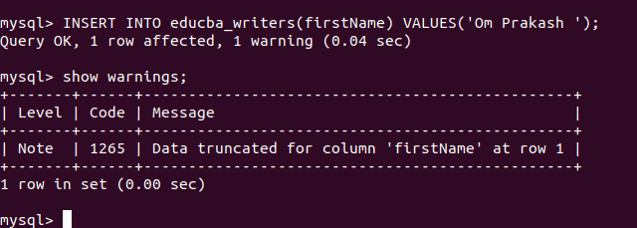


In MySQL the national character set is UTF-8. Types use a predefined character set which can be different from the database character set. The database character set is used to store CHARĪnd VARCHAR columns. You can even define a specific character set at the table and column level, but this is not The server character set defines the default forĭatabase character sets if not specified in the CREATE DATABASE command. There are different configuration levels to define the character MySQL can support multiple character sets, you can run the SHOW CHARACTER SET MySQL uses character length semantics to define the size of CHAR/VARCHARĬolumns, while Informix and Genero use Byte Length The Large Object type to store SBCS or MBCS character data using SBCS or MBCS character data using the national character set, Where n is specified in characters (max is 65535 characters) Where n is specified in characters (max is 255 characters) SBCS or MBCS character data using the database character set, MySQL character data types MySQL data type MySQL and MariaDB support the following data types to store character data: Table 2. Other databases) Oracle® MySQL and MariaDB N that you specify in CHAR(N) is expressed in bytes, not characters as in some Informix uses Byte Length Semantics (the size Variable.The character set used by applications is defined by the CLIENT_LOCALE environment The character set used to store strings inĬHAR/VARCHAR/NCHAR/NVARCHAR columns is defined by the DB_LOCALE environment NCHAR types use the collation order, while CHAR types The only difference betweenĬHAR/VARCHAR and NCHAR/NVARCHAR is in how they use sorting: Single-byte or multibyte encoded character strings. Max size varies depending on the IDS versionĬHAR/VARCHAR and NCHAR/NVARCHAR data types can be used to store SBCS and MBCS character data (max is 255 bytes) SBCS and MBCS character data (max is 32767 bytes) Informix character data types Informix data Something like this should be returned.Informix supports the following character data types: Table 1. Then show the column again to validate that the column was updated. alter table db001.table001 modify column002 char(50) alter table db001.table001 modify column001 varchar(250) not null Īnd here is an example for a char column. Refer to Understanding PRIMARY KEY and auto_increment. For this reason, the new column cannot have the PRIMARY KEY set (nor would it make any sense for the new column to have the PRIMARY KEY set).

Notice in this example that the "id" column has the PRI (PRIMARY KEY) set and auto_increment. Each table can have only one column set as the PRIMARY KEY. In this example, column001 is updated to varchar(250). | id | int(11) | NO | PRI | NULL | auto_increment | | Field | Type | Null | Key | Default | Extra | Notice in this example that column001 type is varchar(200). In this example, the columns in table001 in the database named db001 will be described. The show columns or describe commands can be used to list the columns in the table. You will probably want to show the columns in the table that you want to add a column to. You will first need to log into your MariaDB or mySQL server or configure passwordless authentication and then use the -e command line option and the user must have the Alter_priv. The alter table command can be used to change the size of a column in a table.


 0 kommentar(er)
0 kommentar(er)
